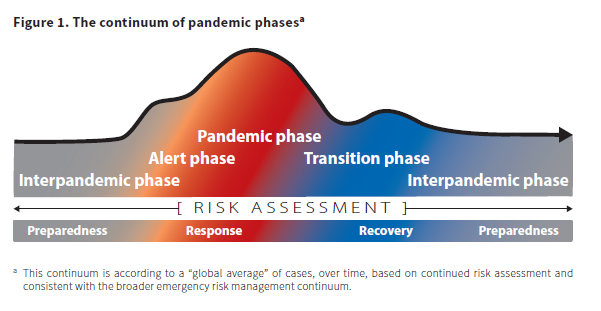Phases of a Pandemic

Understanding the Phases of a Pandemic
Estimated Reading Time: 2 Minutes
A pandemic is an epidemic that spreads across multiple countries or continents, often affecting a large number of people. Whether it’s COVID-19, swine flu, or smallpox, the term “pandemic” is used in various contexts. But what does it truly mean, and when is it appropriate to call something a pandemic? A pandemic refers to a disease that has a widespread presence across regions, impacting global populations. The World Health Organization (WHO) officially declared COVID-19 a pandemic, demonstrating the severity of its spread.
The CDC’s Framework for Monitoring a Pandemic
The Centers for Disease Control and Prevention (CDC) uses the Pandemic Phases Framework (PPF) to track the stages of an influenza pandemic, which has also been applied to COVID-19.
Phase 1: Research and Identification
In this initial stage, a new virus is identified. Research focuses on its origins, including whether it affects animals or humans. This phase is crucial for understanding the potential impact on public health.
Phase 2: Detection and Increased Awareness
During this phase, clusters of infections begin to emerge. There is an increasing possibility that the virus can spread from person to person. Health authorities begin monitoring the situation more closely, and the virus’s potential for global spread becomes clearer.
Phase 3: Virus Spread and Confirmation
At this stage, sustained person-to-person transmission of the virus is confirmed. The virus is now a serious threat, and health officials may begin preparing response measures to limit its spread.
Phase 4: Escalation of Infections
As the virus continues to infect susceptible individuals, measures such as school closures, social distancing, and public health campaigns (such as promoting vaccines or antiviral treatments, when available) may be implemented to slow the spread.
Phase 5: Slowdown in Cases
In this phase, the rate of infection begins to decrease. Public health measures may continue, but there is an overall decline in the number of new cases, signaling that the pandemic is reaching a plateau.
Phase 6: Ongoing Monitoring and Preparedness
Even after the pandemic subsides, monitoring continues to ensure the virus does not resurge. Health authorities prepare for potential future outbreaks or waves of illness.
For the most up-to-date information on COVID-19, visit our dedicated coronavirus information page.
💡 Frequently Asked Questions
What does pandemic genuinely necessarily mean, and the moment is the expression extremely warranted?
Answer coming soon. We are working on detailed responses to this common question.
⭐ Expert Tips
- Include seasonal or trendy variations to keep your meals exciting.
- Highlight prep shortcuts or time-saving techniques for busy cooks.
- Consider dietary restrictions and include substitution suggestions.
✅ Key Takeaways
- These dinner ideas are perfect for impressing guests or enjoying special occasions.
- Choose recipes that match your skill level and available kitchen tools.
- Presentation and taste both contribute to a memorable dining experience.
📣 Join Our Community
Want more inspiration like this? Subscribe to our newsletter for weekly dinner ideas and cooking tips!



